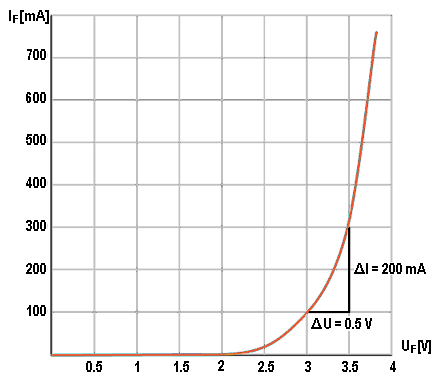Characteristic curve
The characteristic curve of an LED is strongly non-linear. An LED is non-conductive if no external voltage is applied. The LED starts to conduct when the applied forward voltage UF is at least as high than the conducting voltage UD and the band gap is overcome by the electrons. The forward current is not proportional to the applied forward voltage. A small change in voltage can cause a large change in current. A small voltage change can lead to a strong change in light emission due to the proportionality of luminous flux and current intensity. This means that LEDs must generally be operated with a current limiter of some form or other, otherwise even slight fluctuations in the applied voltage can destroy the LED.
 Fig.12: Example characteristic curve of an LED
Fig.12: Example characteristic curve of an LEDA gradient triangle is drawn on the example characteristic curve. On the basis of this gradient triangle it can be seen that a small change in the voltage of 0.5 V from 3 V to 3.5 V results in a large change in the current intensity of 200 mA from 100 mA to 300 mA. In this example case, a voltage change of less than 17% results in a current change of 300%.
This example shows that small voltage fluctuations lead to large changes in the current through the LED and thus to large changes in the luminous flux.